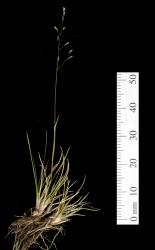- Taxon
- Gallery
- = Catabrosa antarctica Hook.f., Bot. Antarct. Voy. I. (Fl. Antarct.) Part I, 102, t. 56 (1845)
- ≡ Triodia antarctica (Hook.f.) Benth., Journal of the Proceedings of the Linnean Society. Botany. 19: 111 (1881)
- ≡ Sieglingia antarctica (Hook.f.) Kuntze, Revis. Gen. Pl. 2, 789 (1891)
- = Deschampsia novae-zelandiae Petrie, Trans. & Proc. New Zealand Inst. 23: 402 (1890 [1891]) – as novæ-zelandiæ
- = Deschampsia hookeri Kirk, Journal of Botany 29: 238 (1891) nom. superfl.
Slender, erect, smooth, glabrous, leafy tufts, often stoloniferous and forming swards, 5–35–(55) cm, with delicate shining panicles. Leaf-sheath membranous, broader than leaf-blade, distinctly ribbed, midrib more prominent, lower sheaths usually reddish brown, sometimes light greyish, upper sheaths light green. Ligule (0.5)–2–4.5–(7) mm, tapering to acuminate tip. Leaf-blade 1–8 cm × 0.3–0.7–(1) mm, involute to ± flat, often filiform, sometimes disarticulating at ligule, glabrous; margins minutely scabrid, tip acute. Culm erect or ascending, branched at base. Panicle (1.5)–2–14 cm, slender, lax; branches filiform, erect to later spreading, smooth to minutely scaberulous, tipped by few spikelets. Spikelets 2.2–4.5 mm, green to brown, sometimes purplish. Glumes unequal, < spikelet, keel sometimes minutely scabrid near tip, and margins minutely ciliate-scabrid; lower 1–2 mm, 1-nerved, narrow-lanceolate to narrow-elliptic, acute, upper 1.5–2.7 mm, 3-nerved, elliptic-ovate to ovate, subacute to subobtuse. Lemma 1.4–2.2 mm, ovate-oblong, hyaline, irregularly 3–5-toothed, sometimes minutely mucronate or with a minute subterminal awn to 1 mm. Palea narrower than lemma, keels sparsely ciliate-scabrid or glabrous. Callus hairs c. 0.1 mm. Rachilla glabrous, rarely with one or two minute (c. 0.1 mm) hairs. Anthers 0.2–0.6–(0.7) mm. Caryopsis 0.8–1 × 0.3–0.4 mm. 2n= 26.
[From: Edgar and Connor (2000) Flora of New Zealand. Volume 5 (second printing).]




